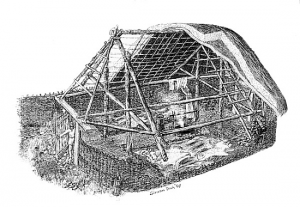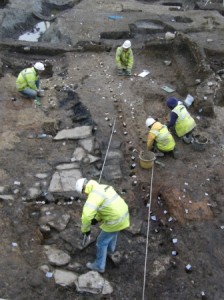
I see on the news that archaeologists Alan Hayden and Co. uncovered what may be the remains of two Viking houses in Temple bar, Dublin. Exciting stuff! These structures appear to have been located on an island in the River Poddle, and thus would have been located outside of the Viking city walls. Although details of the two buildings remain sketchy, as the excavation is still ongoing, they do add to a growing corpus of Viking houses that have been recently uncovered outside the old city walls of Dublin.
On the south side of the city Claire Walsh identified a sequence of post and wattle structures of probable 11th/12th date at Cork Street, Dublin. These small buildings were well preserved beneath the basement floors of later 18th century buildings and seemed to represent a line of Viking houses, which fronted onto Cork Street. The buildings were located at quite a remove from the walled town and indicate that expansive suburbs must have stretched out from the arterial routeways leading into the Viking city.

Similarly on the north side of the river Colm Moriarty excavated the remains of a large Type 1 Viking house which fronted onto Church Street, the main road leading from the north of the country into the walled town of Dublin. This building was of an identical type to the Viking houses excavated by Dr. Patrick Wallace and the National Museum of Ireland during the Wood Quay/Fishamble Street excavations and was the first conclusive evidence for Viking settlement on the northern banks of the Liffey. The house was defined by post and wattle walls of hazel and alder and had internal roof supports and a central hearth. It was located right on the river Liffey foreshore and was protected from tidal flooding by a series of earthen banks and post and wattle breakwaters. Radiocarbon dating suggested the building was probably 11th century date and historical records indicate that it was located in area that was to become known as Ostmanstown during the later medieval period. This area was reputedly where the Viking inhabitants of Dublin were evicted to after the fall of the city to the Anglo-Normans in 1170. Ostman is a corruption of “Men from the East”; that is, the Vikings.
Together these new Viking houses demonstrate that during the 11th and 12th centuries Dublin was an ever-expanding city whose suburbs extended well beyond the city walls. The question now is where will the next houses turn up?
Link



3 thoughts on “New Viking houses found in Dublin”